Day 1-2 Week 5
I spent the weekend in Paris. The main reason for my visit was to see the show “Les Temps Mérovingens” at the Cluny Museum. The Merovingian times were the heirs of the Roman Empire. Throughout this show one could see the development of original forms of expression unique to this period but developed through a knowledge of the Roman era. With over three hundred years of rich arts and letters, from the middle of the fifth to the middle of the eighth century, I was able to better understand the beginnings of France and its culture. The curator of the show is Isabelle Bardies-Fronty who gave me a personal tour. It was especially well done in that Isabelle did not follow conventional wisdom in curating the show. She chose to highlight, through innovative juxtapositions, how the art was a creative bridge between the Roman Empire, recently collapsed, and the first king of the Franc Empire, Clovis. It was also wonderful to see an emphasis on art that was of its time—and unique for itself. She explained that one reason for this was the misconception, brought on by Charlemagne propaganda, that Merovingians were not artistic within their own context and era. This notion is dispelled brilliantly but Isabelle’s curation.
In addition to this show, I also visited the Frédérick Bazille (1841-1870) retrospective at the Musée d’Orsay. From the museum’s description:
How should we consider the work of Frédéric Bazille, who died in combat in 1870 during the Franco-Prussian War aged just 28? Although his early paintings are clearly those of a budding painter, influenced by Realism and by his friend Monet, he nevertheless went on to complete numerous masterpieces in which he gradually asserted his unique talent.
Around sixty paintings have come to us, each one a challenge, another milestone for the young artist, enabling us to follow his progress towards the increasingly personal expression of his “temperament”, in the words of the time. Organized both thematically and chronologically, the exhibition places the works of Bazille amongst those of his contemporaries like Delacroix, Courbet, Manet, Monet, Renoir, Fantin-Latour, Guigou, Scholderer and Cézanne. These confrontations place his work at the heart of the great issues of avant-garde painting in the 1860s (modern life, the renewal of traditional genres such as portrait, the nude and still life, plein air painting and peinture claire, etc.), to which Bazille made a considerable contribution, and which also highlight the great originality of his inspiration.
The exhibition thus invites us to take another look at an artist who, in spite of his early death, was a key figure in the birth of Impressionism. The most recent research and scientific studies in particular shed light on Bazille’s methods of working and his links with Monet and Renoir, and reveal evidence of works that were thought to have disappeared – the missing links in an unusual body of work.
I also visited an installation by Chibaru Shiota “Where are we going?”—150 white boats floating within the atria of the Bon Marche department store. This was an inspirational show despite it being in a commercial setting. Her art work was based on the premise that “Life is a voyage without a destination.”
I was also able, in the short weekend, to stop by see the restoration of the Delacroix paintings in the Chapel of the Holy Angels that is finally completed. It now now looks (almost) like it did when finished 155 years ago in 1861. The last several times Lea and I have been to see it, it has been covered with scaffolding.
Finally, while at the d’Orsay Museum I again went to see the William Bouguereau paintings “Birth of Venus” and “Dante and Virgil” (two of my favorites) and paintings by Vuillard and Bonnard in a new setting of their paintings based on the bequest to France from Zeïneb and Jean-Pierre Marcie-Rivière. These 25 paintings and 94 drawings by Bonnard; and 24 paintings, 3 pastels and 2 drawings by Vuillard are displayed together for the first time since they came to the State upon the death of Jean-Pierre Marcie-Rivière on 6 January 2016.
Finally, I returned to one of my favorite eateries in Paris, Huitrerie Régis for oysters. Always a treat.
2017.01.30 Day 3 Week 5 Class #16
Today we continued to work on our value studies and the Bargue #2 in the morning. In the afternoon, I worked on drawing “negative” spaces—the class I missed on Friday. This entailed drawing the space in between and around the figure—not the figure itself.
2017.01.31 Day 4 Week 5 Class #17
Continued to work on our value studies and the Bargue #2 in the morning. In the afternoon, we began a two day pose. In the evening we had our anatomy lecture. The topic this time was the legs.
2017.02.01 Day 5 Week 5 Class #18
Sick today. Missed the full day of classes. Picked up a stomach bug. Slept about 18 hours. Besides the bug, I think my body was saying “slow down and take it easy—you ain’t that young anymore.”
2017.02.02 Day 6 Week 5 Class #19
I slept in this morning. Felt a little better so only missed half day of class. In the afternoon we worked on another long pose to refine our ability to understand gestures and translate them to an articulated model. Getting better at relationships and form. Still need work on placement of major landmarks vertically and the proportional widths of the legs and arms.
2017.02.03 Day 7 Week 5 Class #20
 Today was a full day having slept really well last night and only eaten oatmeal. Feeling at about the 75% level today. Tomorrow I hope to make up for the lost day by getting my value sphere and bargue #2 ready for final critique on Monday. Besides continuing with the value study and the Bargue, the afternoon we focus on feet and hands. 3 hours for two tiny drawings. These two appendages are complex and the number of subtle points far exceeds what one my guess just from a quick glance. The other complexity is the subtle changes in direction, the way weight is transferred (the foot, of course), and the grouping of the fingers and toes into “sets” which vary based on the pose. We were only focusing on the contour and the major shadow shapes. We could not draw details—which was very hard to resist doing. I did start to see the logic. After the plumb line is established and the overall boundaries are established, the following steps are taken:
Today was a full day having slept really well last night and only eaten oatmeal. Feeling at about the 75% level today. Tomorrow I hope to make up for the lost day by getting my value sphere and bargue #2 ready for final critique on Monday. Besides continuing with the value study and the Bargue, the afternoon we focus on feet and hands. 3 hours for two tiny drawings. These two appendages are complex and the number of subtle points far exceeds what one my guess just from a quick glance. The other complexity is the subtle changes in direction, the way weight is transferred (the foot, of course), and the grouping of the fingers and toes into “sets” which vary based on the pose. We were only focusing on the contour and the major shadow shapes. We could not draw details—which was very hard to resist doing. I did start to see the logic. After the plumb line is established and the overall boundaries are established, the following steps are taken:
- The gesture stage, drawn with a soft “ghostly” line, establishes the overall form which marks where the horizontal and vertical placement of the key turning points. This establishes the altitude and angle of the shoulders and hips—the two main axis of the body.
- With only soft sketchy straight lines, draw, as accurately as sight measuring allows, the changes of direction along the gesture drawing (keeping the gesture visible) that are formed by the bony points of the torso and the more detailed turning points of the figure. This is called the construct stage.
- Major shadow shapes are found and shaded evenly to a value of 3-4.
- The next stage, known as the articulation stage, its purpose is to refine the drawing by locating and articulating the smaller undulations, overlaps and, minimally some internal information (very slight.)
There will be much practicing with these complex human body arts in my future. Tonight was simple; finished the week’s blog, soup and to bed. I am looking forward to Sunday. If the weather cooperates I will try to make up for lost miles.
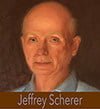

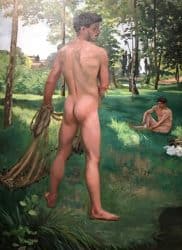

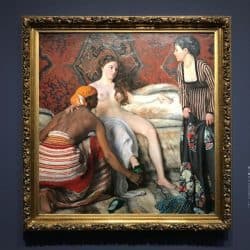
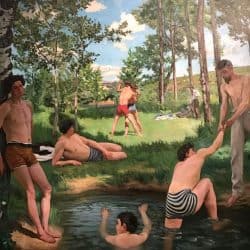
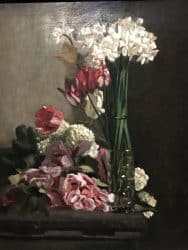
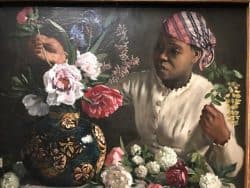
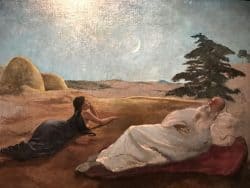
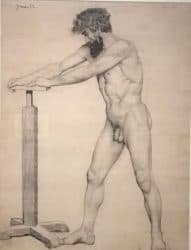
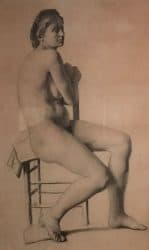
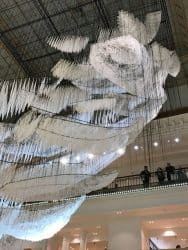
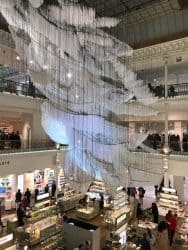
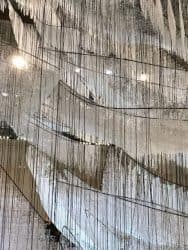
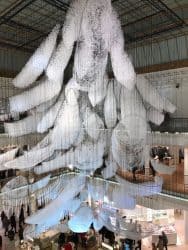
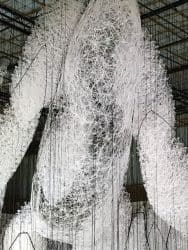
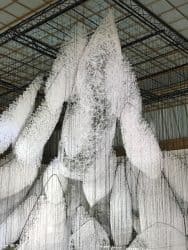
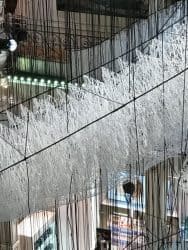
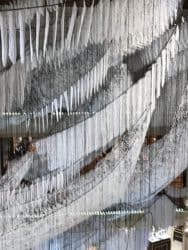
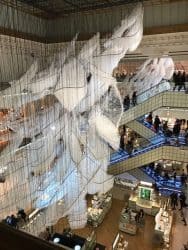
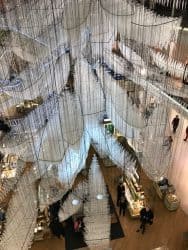
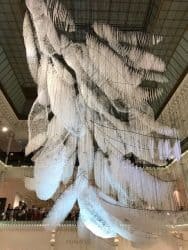
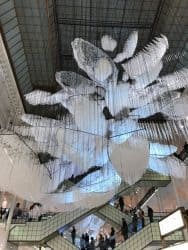
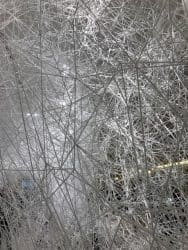
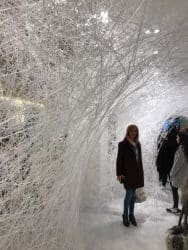
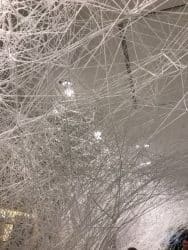
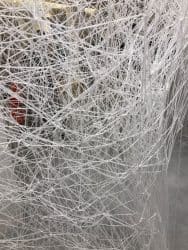
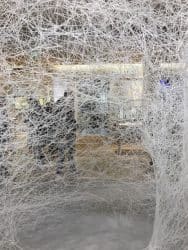
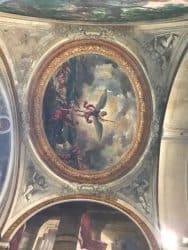



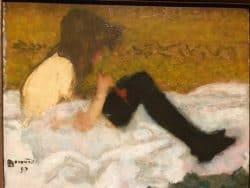
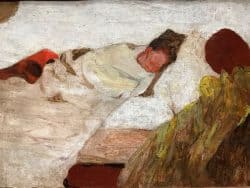
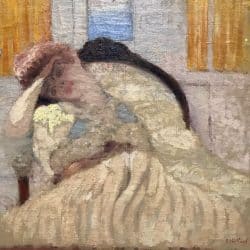
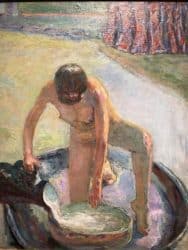
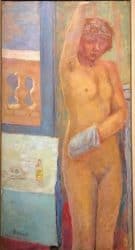
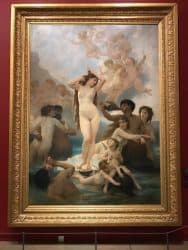
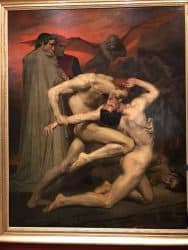
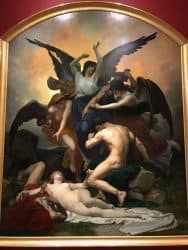

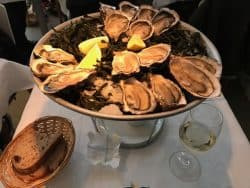



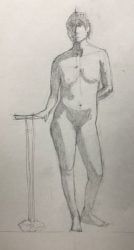
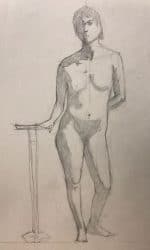

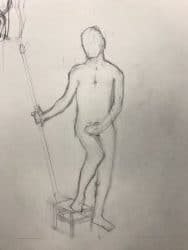

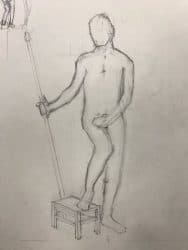
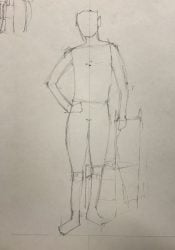
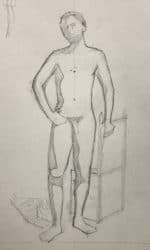
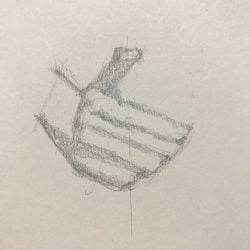
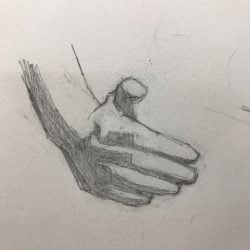
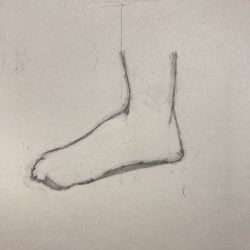
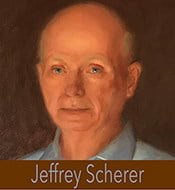
Recent Comments